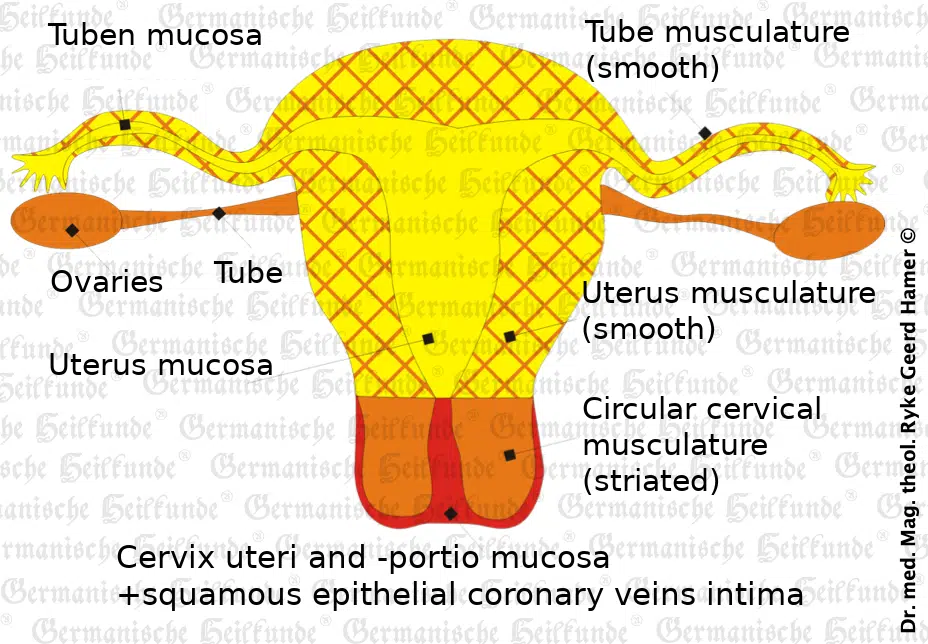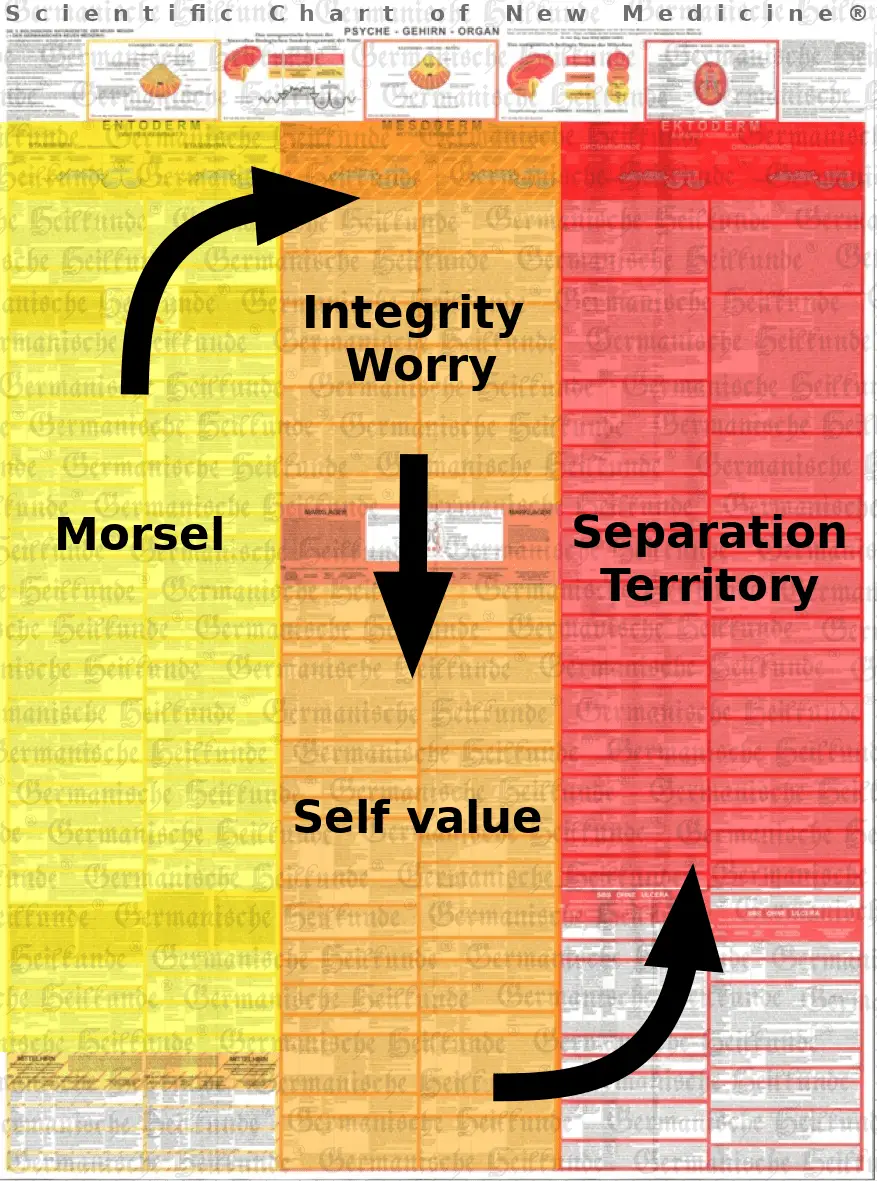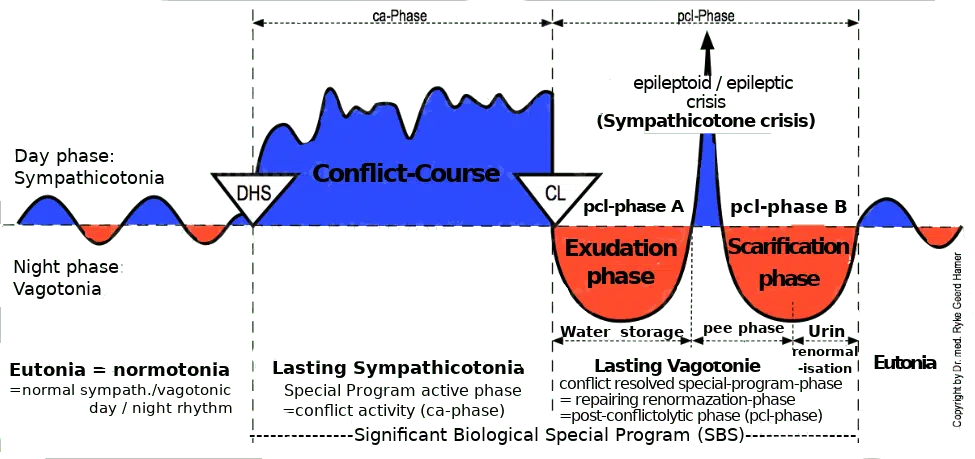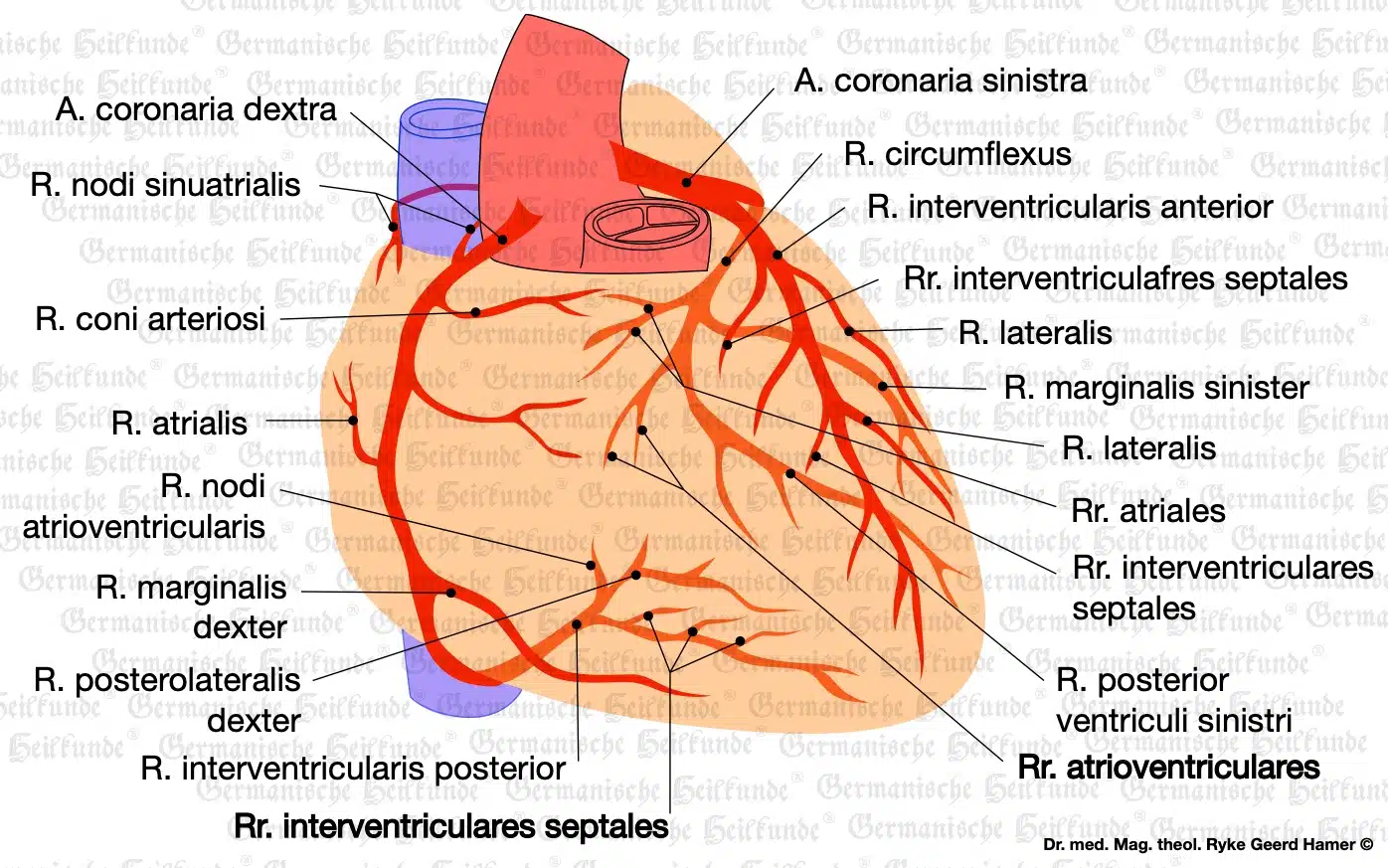The uterus is composed of four different tissues :

We, physicians, have always wished for a science of medicine that functions according to scientific methods and laws. Strictly speaking, we always believed that we were allowed to feel predominantly like natural scientists. But the reality is different. There are too many hypotheses that need to be believed and they are often only apparent proofs because we do not have natural biological laws as in the natural sciences. All medicine is purely symptomatic. Diseases are diseases of the organ and, as such, are to be treated purely organically and symptomatically.
Everything is treated with infusions and scalpels. The psyche is considered ‘unscientific.’ The psyche and the brain, from which everything in our organism is controlled, are utterly uninteresting. As a result, we have never been able to find a connection between the psyche and organs, nor between conflicts and organs.
In Germanische Heilkunde®, the only meaningful categories in the entire science of medicine is the developmentally oriented division according to germ layer affiliation: the inner (endoderm), the middle (mesoderm), and the outer germ layer (ectoderm), from which all organs can be derived.

These two different organs seem to have grown together to form one organ, the uterus. However, they originate from different germ layers with regards to their mucous membrane. And each has its relay centers in entirely different parts of the brain. The cervix and the cervical orifice relays are in the peri-insular area of the cerebrum on the left, and the uterine body mucosa in the pons of the brainstem. In addition, the histological formations are also utterly different from each other:
And, of course, the conflict contents are also entirely different for these two organs. In order to understand the conflict contents it is necessary to look at developmental history because only then can we also understand the biological “territory conflict.” The female sexual conflict “of not being mated,” the “territory marking conflict” (= bladder ulcus because the mammal marks the territory with the urine), and so on.
In Germanische Heilkunde all ‘illnesses’ run according to 5 biological laws. If there was one disease that did not occur according to these 5 laws then the Germanische Heilkunde® would be wrong.

Every ‘disease’ or cancer equivalent begins with a DHS (Dirk Hamer Syndrome), an acute dramatic conflict experience shock. This so-called DHS is experienced by a person in such a way that it makes him freeze, unable to speak, catches him “on the wrong foot” and constellates him (constellation is having at least 2 active biological conflicts). It is not a slow build up to a conflict that causes cancer, nor is it a conflict situation that is a person is able to manage and deal with in a calm manner.
Most patients know the DHS almost to the minute because it is always dramatic. The content of the conflict determines, at the moment of the DHS, both the localization of the Hamer Focus (HH) in the brain (shooting target shaped), which is visable in the brain in the same second as the DHS and the localization of cancer or cancer equivalent in the organ.
Example: A woman catches her husband in bed with her best friend. She suffers a sexual frustration conflict. In biological language this would be a conflict “of not being mated,” with a cervical carcinoma on the organic level if the woman is right-handed. However, the same conflict is not experienced by everyone in the same way. Suppose the woman was no longer fond of her husband and had been thinking about divorce for a while. In this case, she will not perceive catching her husband and best friend in flagrante delicto as a sexual conflict. But at best, as a human conflict of lack of solidarity with the family. This conflict would be a partner dispute conflict that would cause breast cancer in the right breast if the woman is right-handed. The same physical event as seen by two different psychological constellation is experienced in entirely different ways producing entirely different outcomes.
What is important is the situation and how the patient experiences it psychologically at the moment of the DHS. In this case, the same event could also cause a fear-disgust conflict with hypoglycemia. i.e., hypoglycemia of the blood, if the woman had discovered her husband in a very ugly situation, e.g., with a prostitute. Or it could cause a self-esteem conflict with or without sexual conflict if the woman had discovered her husband with a girl 20 years younger. The feeling would then have been something like, “I can’t compete with that, I can’t offer him that.” In such a case, the skeletal system of the pubic bone of the pelvis would be affected, where osteolysis, i.e., bone decalcification, would show up as a sign of sexual self-value collapse. All these things must be known to find out what the patient was thinking at the DHS moment. But the woman does not necessarily have to suffer a conflict at all. She will suffer a conflict only when one or more aspects of the situation hit her unexpectedly.
Another crucial criterion is that the brain’s Hamer Focus (HH) localization is predestined. This means that the relay (one of several hundred possible) is already determined beforehand. And this relay (in the case of disease HH) must now have precisely the formation which belongs to the corresponding phase.
Every disease that has a conflict resolution (CL) also has a ca-phase (conflict-active phase) and a pcl-phase (healing phase), according to the law of the two-phase nature of all diseases when the conflict is resolved. And each pcl-phase, unless interrupted by a conflict-active relapse, has an epileptoid crisis (turnover point of the healing phase) at the lowest point of vagotonia.
Tumors do not form in the conflict-active phase. According to the histology of the outer germ layer, ulcers form at the cervix or cervical portio. Simultaneously, ulcers form in the coronary veins, accompanied by mild angina. In addition, the right-handed woman immediately has amenorrhea, i.e., absence of menstruation. As long as the conflict continues the ulcers enlarge and an increasingly larger area in the brain is also altered.
When there is conflict resolution (CL), the cervical or portio-Ca stops proliferating. Bleeding from the cervical/portio ulcers occurs as a sign of healing. The coronary vein mucosa now swells, and 2 to 6 weeks later, the epileptic crisis occurs, with acute right heart failure, and a right heart infarction. This epileptic crisis has always been misinterpreted as a so-called pulmonary embolism.
The reparative processes in the brain begins at the moment of CL. Immediately after the CL, the HH can been seen more clearly in the brain because it now enters the stage of repair and becomes ‘metabolically hot,’ i.e., it turns white in the computer tomogram. If the HH is discovered by a conventional doctor it will be misinterpreted, unfortunately, as a brain metastasis or brain tumor.
The clapping test to determine left and right-handedness is crucial in Germanische Heilkunde®. From the cerebellum onwards, right-handedness and left-handedness become essential. With the beginning of the very first cell division, the development of the computer part of the brain begins, the cerebellum, and with it the differentiation into right-handedness and left-handedness. We see the ‘laterality’ only in the organs controlled by the cerebellum. It is partly belonging to the cerebellum bridge angle, the connection of the brainstem and cerebellum. Therefore, the correlation is crossed from the brain to the organ for all cerebellum relays and the entire cerebrum. Nevertheless, cerebellum and cerebrum relays differ from each other, although handedness applies to both in the same way. As an example, a right-handed woman gets cervical or cervical-portio-Ca from a sexual conflict, with coronary artery ulcers, and amenorrhea. After CL, she suffers a so-called pulmonary embolism.
On the other hand, a left-handed woman cannot get cervical or cervical-portio cancer from a sexual conflict. Although she can get coronary artery ulcer Ca, along with depression. She also continues to have her menstrual period, but she suffers a heart attack after CL, that is, during the healing phase. Only after menopause can a left-handed woman get cervical or cervical-portio-Ca with coronary artery ulcers in a territorial conflict. In the healing phase, she can get what doctors call a pulmonary embolism.
Conversely, a right-handed woman can also get a territorial conflict first, with a coronary artery ulcer-Ca. She still suffers a heart attack in the healing phase.
Exceptions are hormonal changes, birth control pills, or schizophrenic constellations.
Developmentally, left-handedness must have been the standard case because the left-handed woman closes the right (male) side of the brain in the ca-phase, she becomes depressed but doubly sexually active. By this hypersexuality, she virtually forces the conflict resolution of “not having been mated.”
All these are verifiable and largely predictable facts, except for the DHS, which catches us “on the wrong foot” unexpectedly. Since we know the principle of cancer, therapeutically we also have entirely different possibilities than before. There are not so many subsequent conflicts, especially panic conflicts. Suppose the patient has understood the system from the very beginning, then in this case, she is entirely relaxed about the already predictable symptoms, especially in the healing phase.
The uterine body mucosa-Ca is, histological, an adeno-Ca. The HH is located in the brainstem (middle of the pons), and conflictively, here lies an ugly, semi-genital conflict, usually with males, a loss conflict, especially grandmother/grandson conflict, underlying. Semi-genital means that the conflict content’s focus does not revolve around the purely genital area (real or figuratively). The genital theme occurs as ‘accompanying music,’ whereby this conflict is different from the sexual conflict.

a compact tumor grows in the “cavuum uteri” because the uterus’ endometrium is a modified intestinal mucosa (adeno-Ca).
With conflict resolution there are again two possibilities in the healing process:
1. postmenopausal: The tumor is necrotizing. Fluor vaginalis with possible light bleeding.
2. premenopausal or normally menstruating: The tumor is shed with hefty bleeding.
Fallopian tube Ca = tubal-Ca is also an adeno-Ca. The HH is also located in the brainstem (pons, ventral left medial) and has an ugly, semi-genital conflict content, usually with a male.
Example: An elderly factory owner learns that an executive has been caught with an underage girl. She also has to pay him a high compensation to get rid of him.
A compact fallopian tube-mucosa adeno-ca, grows with almost regular total obstruction of the fallopian tube in the conflict-active phase. In the healing phase there is caseating necrotization of the tumor by fungi or fungal bacteria (if present), fluor vaginalis occurs—occasional drainage of pus into the abdominal cavity.
On the other hand, the Uterine body muscle-Ca belongs to the midbrain endoderm (smooth muscle), making a compact tumor (myoma) in the conflict-active phase. The underlying conflict is “not being pregnant.” In the healing phase, the uterine myoma remains. In all smooth muscle SBSs, the enhancement remains and is not degraded.
Suppose, with the help of Germanische Heilkunde®. A patient can understand what and why something is happening in her body. In this case, she no longer has to panic before this frightening set of hypotheses about incomprehensible, senseless, or unstoppable processes. In most cases, she will not suffer second cancer and will survive these special programs of nature.
After the discovery of the Iron Rule of Cancer and the Hamer Focus in the brain, understanding evolution was the key to the vast order that encompasses all medicine and biology. This order extends to the human and animal behavioral domains, the localization of the Hamer Focus in the brain, and the tumors’ organ affiliation classification.
Copyright Dr. Hamer
Translated: John Holledauer
TODAY: 4
LAST 30 DAYS: 3.891
THIS YEAR: 32.411
TOTAL: 151.526
| Cookie | Duration | Description |
|---|---|---|
| cookielawinfo-checkbox-analytics | 11 months | This cookie is set by GDPR Cookie Consent plugin. The cookie is used to store the user consent for the cookies in the category "Analytics". |
| cookielawinfo-checkbox-functional | 11 months | The cookie is set by GDPR cookie consent to record the user consent for the cookies in the category "Functional". |
| cookielawinfo-checkbox-necessary | 11 months | This cookie is set by GDPR Cookie Consent plugin. The cookies is used to store the user consent for the cookies in the category "Necessary". |
| cookielawinfo-checkbox-others | 11 months | This cookie is set by GDPR Cookie Consent plugin. The cookie is used to store the user consent for the cookies in the category "Other. |
| cookielawinfo-checkbox-performance | 11 months | This cookie is set by GDPR Cookie Consent plugin. The cookie is used to store the user consent for the cookies in the category "Performance". |
| viewed_cookie_policy | 11 months | The cookie is set by the GDPR Cookie Consent plugin and is used to store whether or not user has consented to the use of cookies. It does not store any personal data. |
You’ll be informed by email when we post new articles and novelties. In every email there is a link to modify or cancel your subscription.